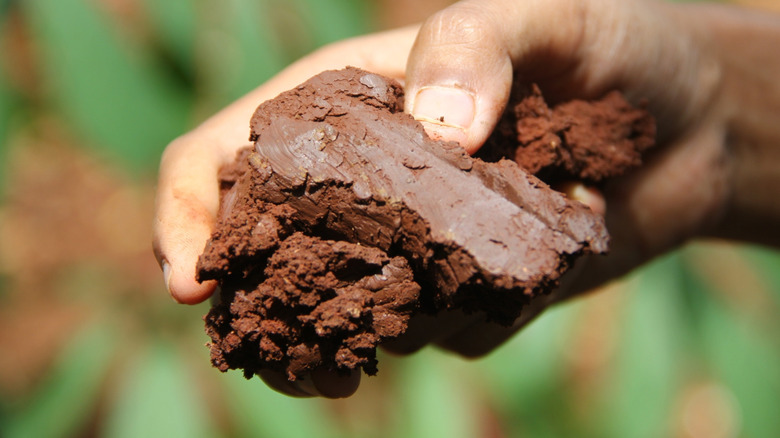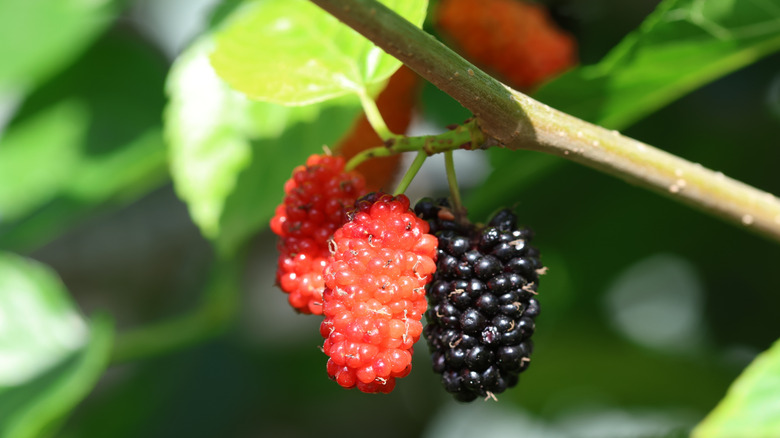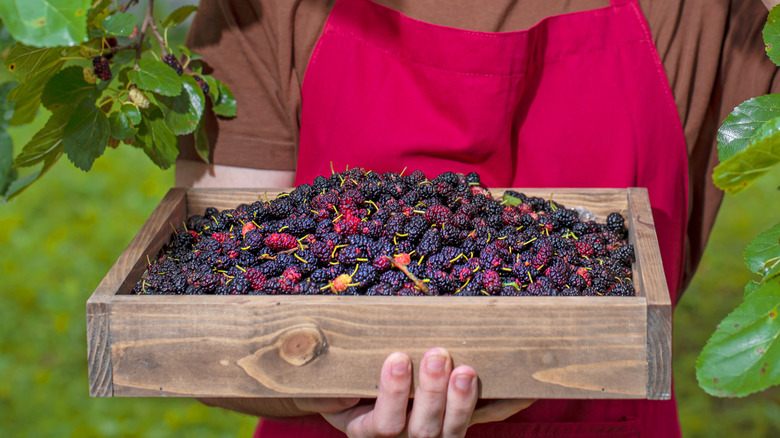The Fast-Growing Fruit Tree That Will Happily Grow And Flourish In Clay Soil
Gardeners deal with clay soil in two ways. The first is to amend the soil in an effort to deal with its drainage and compaction issues. This usually involves digging, shoveling in organic matter and gypsum, breaking up the compacted clay, and working it in. So, it's a lot of digging and can take years. The second clay coping mechanism, which you can pursue while you're working in amendments, is to select plants that are pretty happy in clay. Enter the red mulberry, a lovely fruit tree that birds love and that's content to live, grow vigorously, and even thrive in clay.
House Digest spoke exclusively with author, podcaster, and fruit tree expert Josh Gardens about growing red mulberries in clay ... and he knows a thing or two about growing in clay. "As a gardener in the Carolinas," Josh said, "I've learned firsthand the unique challenges that come with growing trees in heavy red clay soil." Clay presents a few particular difficulties for gardeners and orchardists, notably drainage and soil compaction problems. "One of the biggest obstacles is poor drainage," Josh explained. "Clay's fine particle structure holds water exceptionally well, sometimes too well, creating conditions ripe for root rot, especially in trees that can't tolerate consistently wet feet."
But take heart. "While clay can be difficult, it's not a death sentence for gardening," Josh said. It's simple enough to grow and take care of mulberry trees, which he said are "surprisingly resilient and can even thrive in such conditions."
Growing red mulberries in clay soil
Of course, a tree's willingness to survive in clay soils is not the same thing as the ability to thrive ... and thriving is often required for fruit trees to produce fruit. Speaking exclusively with House Digest, Josh said that red mulberry is one of the better choices for clay. "Red mulberry (Morus rubra), the only mulberry species native to North America, has proven to be surprisingly well-suited to clay soils in my experience," Josh said. "Compared to other fruit trees like apples or pawpaws, which grow more slowly and show more sensitivity in compacted clay, red mulberry stands out for its resilience."
The keys to success are location, maintenance, and, of course, soil amendments. Because red mulberry is native, it's naturally more adaptable to environmental challenges (note that the non-native white mulberry is listed as invasive in many states, so it's illegal to grow this tree in certain parts of the country). Josh says his own tree is planted on a slight slope, and the resulting runoff reduces drainage problems. He amends its soil with organic matter every year, out to the tree's drip line. It grows quickly in full sun, and he prunes it aggressively to keep its fast growth in check.
All the pruning and amending is a bit of work, but it's the work of gardening. Josh has seen strong fruit production in exchange for his efforts, and he concludes that red mulberry is a good choice for clay soil. "With its aggressive growth, strong fruiting, and tolerance for less-than-ideal soil, red mulberry is one of the more forgiving trees for gardeners dealing with heavy clay," he said.
A recipe for happy red mulberries in clay
If you have clay soil, you likely know about its drainage issues, and you also know that some plants will make the most of it, given no choice in the matter. However, this doesn't always result in the best flower production, fruit crops, and the like. The time-honored approach to this problem is to learn what you can about the plant's preferences and get its environment as close as possible to the ideal. While speaking exclusively with House Digest, Josh told us that while red mulberry will tolerate clay, it prefers better-draining, loamy soil. So, some amount of soil amendment is probably for the best.
As always, sun and water are also big factors in red mulberries' success. "These trees thrive in full sun," Josh said, "and although they can tolerate some shade, fruit production is significantly reduced without at least six to eight hours of direct light." When it comes to water, clay soil can actually be something of an asset because it naturally retains water. And, of course, you must feed the trees well. "These trees appreciate an annual top dressing of organic amendments. I personally use wood chips, leaf litter, and pine straw," Josh said. "If using fertilizer, a soil test is recommended to avoid over-application."
It helps, too, if the tree is grown in the right location. A tree growing in USDA zones 5 to 9 will have the best chance of thriving, which of course means it has the best chance of handling clay soil well. And improving your odds is what growing in clay is all about.


